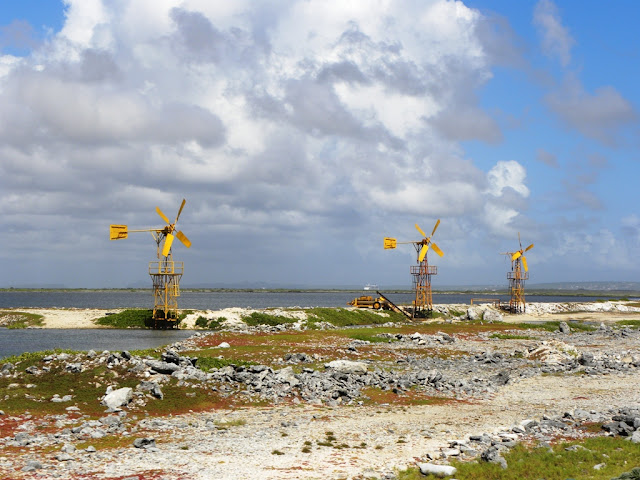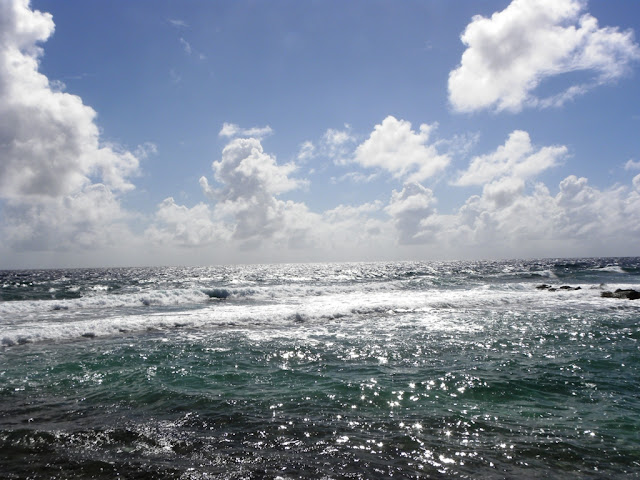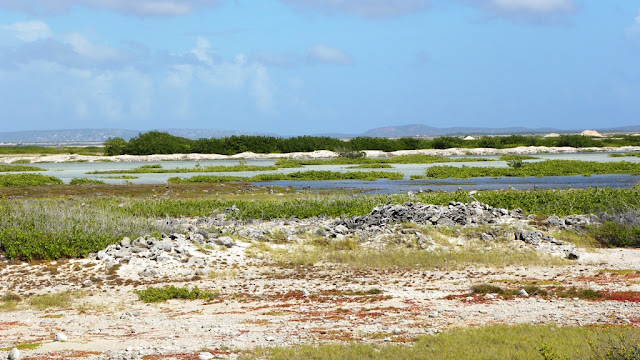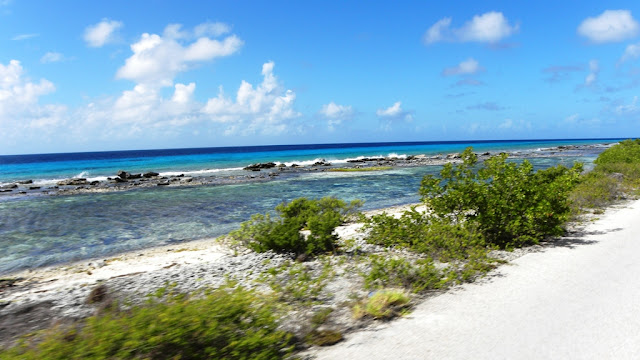We are driving from Lac Bay on the EEG Boulevard to the south of Bonaire where the salt fields of Cargill Salt works are located. We take a picture of the road, rough flat landscape and the clouds. We see the yellow windmills to pump water from one area to a higher one. It is a physical fact that water can not flow upwards without any support. The flood brings sea water to the fields via canals. The burning sun makes the water evaporate. At the end of the process, the water colours pink. These days the salt is extracted and transported by machines.
In the past, it was a different story. From the 17th century, the Dutch used Bonaire as an island for salt plantations. Holland needed salt and could no longer buy it from Spain with who it was at war. The African slaves, Indians and prisoners had to work on the fields and lived in extremely small houses with no comfort at all. It was a struggle to survive. The slaves lived next to fields and each group of houses had a different coloured obelisk and houses (white, orange, red) to show where the cargo ships should collect the salt. For a period of 250 years there were only slaves and guards on the island. The cruel exploitation and slavery was abandoned in 1862. Many European countries should be ashamed about how they conquered the world and established slavery.
We rijden over de EEG Boulevard van Lac Bay naar het zuiden van Bonaire waar de zoutvelden van Cargill Salt Works gelegen zijn. We nemen een foto van de weg, het ruwe landschap en het wolkendek. Gele windmolens pompen het water naar hoger gelegen platforms. Het is fysiek bewezen dat water niet naar boven kan lopen zonder enige ondersteunende krachtbron. Bij vloed loopt het zeewater via kanalen de velden op. De brandende zon laat enkel het water verdampen. Bij het einde van het proces kleurt het overblijvende water roze. Nu in deze moderne tijd wordt alles machinaal ontgonnen en vervoerd.
In het verleden was dit een ander verhaal. Vanaf de 17de eeuw gebruikten de Nederlanders Bonaire als eiland voor zoutplantages. Nederland had zout nodig en kon dit niet meer kopen van Spanje waarmee het in oorlog was. Afrikaanse slaven, indianen en gevangenen werden gedwongen op het veld werken en leefden in barre omstandigheden in zeer kleine huisjes zonder enige voorzieningen. Het was een voortdurige strijd om te overleven. De slaven leefden vlak naast de zoutvlakten in groepen en iedere gemeenschap had een andere kleur van obelisk en huisjes. De obelisk was een merkteken voor de vrachtboten die hun lading kwamen ophalen. Gedurende een periode van 250 jaar leefden er enkel slaven en bewakers op het eiland. De wrede uitbuiting en slavernij werd afgeschaft in 1862. Vele Europese landen moeten zich schamen voor hun veroveringen in de nieuwe wereld en de uitbuiting van slaven..
Previous Bonaire article: The Royal Clipper docked in the port of Bridgetown, Barbados
Previous slave related article: San Pedro Claver church, Cartagena
Return to main page
The Seeds
21 minutes ago











Niettegenstaande al het 'slechte', Filip, toon je ons een machtig-mooie reportage !
ReplyDeleteLie(f)s.
Most lovely photos, and since I'm from snow country of course I never thought of salt fields! A couple blogger friends live in Salt Lake City, Utah and they have salt fields and such. Amazing day you had again!
ReplyDeletemooie foto Filip, maar na de bijgaande uitleg
ReplyDeletezullen we best heel bescheiden blijven
fijne avond
een eendenkooi werd vroeger gebruikt om wilde eenden voor consumptie te vangen;
Deleteals je bij mij op de link klikt krijg je verdere uitleg
Wow that is so interesting and I loved each of the photos! I learn so much from your travels!
ReplyDeleteThe hills of salt look so sculptural, a colourful lovely post.
ReplyDeleteThis was really fascinating and imagine that the tiny house that kristel is standing by is one of the slave dwellings. Hard to imagine people being treated that way isn't it. Must have been a very tough life! Great shots and very interesting post!
ReplyDeleteGreat shots and an interesting history lesson. Slavery in all its forms is abominable. We have pink salt lakes it is caused by a bacteria.
ReplyDeleteOink water - I wonder why. Still a place for extracting so much salt yet with a very sad history.
ReplyDeleteOoops - meant to type Pink water....
DeleteMooie heldere foto's.
ReplyDeleteOnvoorstelbaar wat er al niet gebeurt(de) met de menselijke waardigheid, enkel voor het gewin van enkelingen.
Mooie impressie van dit stukje geschiedenis Filip
ReplyDeletePrachtige kleuren in deze fotoserie.
Enne de huisjes zijn wel erg klein....
Groetjes
:)
Very picturesque. The houses are very small as you said and do not look very comfortable. I see you also have an obelisk in your post. Maybe this is why you thought about Indians.
ReplyDeleteTo see these wonderful, scenic photos, one would not imagine such a cruel past - and all for salt.
ReplyDeleteHow interesting and lovely lanscape! And the litlle house with Kristell. Sweet.
ReplyDeleteYour fotos are wonderful. Thanks for sharing
Wish you a happy next week
orvokki
This reminds me very much of Aruba.
ReplyDeleteVery interesting place again. Thanks for your posts I will know Caribian area very well :)
ReplyDeleteprachtige foto's!!
ReplyDeleteeen streek die veel verhalen zou kunnen vertellen
Stuk voor stuk prachtige landschapsfoto's.
ReplyDeleteOp ons koloniale verleden hoeven we niet trots te zijn, dat toon je hier ook weer duidelijk aan.
Quite an interesting place !
ReplyDeleteWow this is nice! Look at the clear blue sky! I like~
ReplyDeleteLovely place!
ReplyDeleteThe first picture I adore!! What is the yellow tall pyramid? Don't tell me people lived in that tiny house?
ReplyDeleteVery interesting article of the salt fields!
ReplyDeleteLéia
Interesting about the salt, and how we each did a post on same about 'salt'.
ReplyDeleteWe also have pink as in pink lakes in some areas of Australia.
Wat een kleurrijke plaatjes, wat is het daar mooi! Een heel verschil met de sneeuw hier.
ReplyDeleteGr. Nicole
Schitterende landschappen en wow wat een kleuren en diepgang!
ReplyDeleteGroetjes Cristien
Superbes les photos!! j'aime++++ que c'est beau! bisousss
ReplyDeleteinteressante serie foto's en ook verhaal. Ik heb door je verhaal weer iets geleerd. Groetjes, Dietmut
ReplyDeletePeru, zullen jullie geen spijt van krijgen ! Lieve groeten, Dietmut
ReplyDeleteWonderful post.
ReplyDeleteWonderful scenery.
As usual, great pictures.
I send greetings.
Lucia